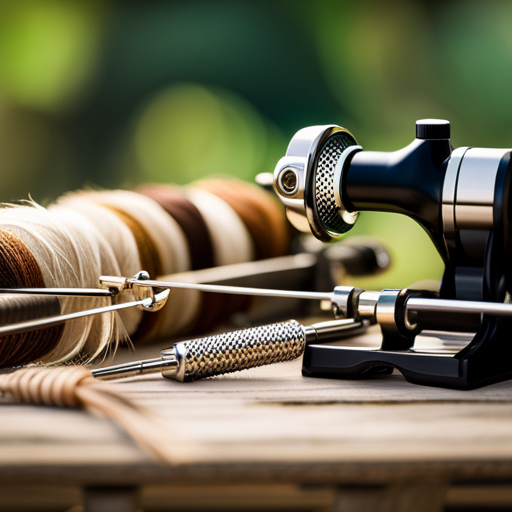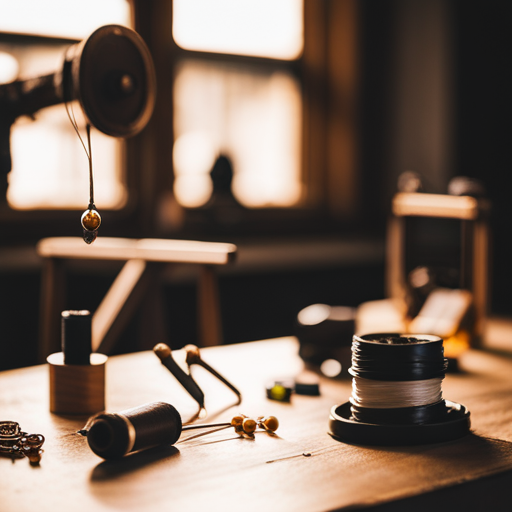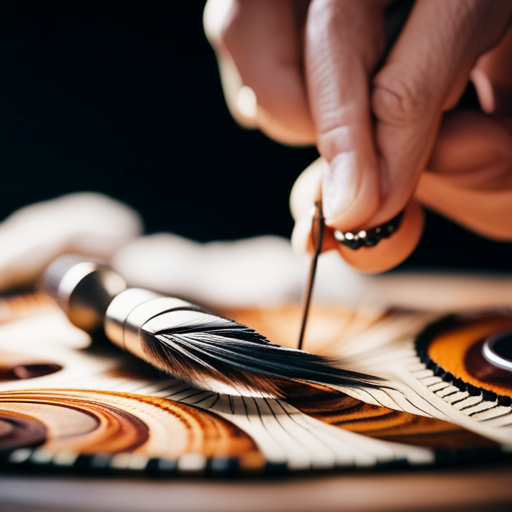In an age where traditional fly fishing techniques are constantly evolving, the art of nymph fly tying remains a timeless and essential skill for freshwater anglers.
As the foundation of an effective fishing arsenal, mastering the intricacies of nymph patterns is crucial for success on the water.
This article delves into the intricate world of nymph fly tying, offering insights into essential tools, techniques, and pro tips for creating realistic imitations that will entice even the most discerning trout.
Importance of Nymph Patterns
The effectiveness of nymph patterns in freshwater fishing is undeniable, making them a crucial component of any angler’s arsenal. Nymphs imitate the aquatic life stage of insects, making them incredibly effective in attracting fish. Understanding nymph fishing strategies and having a solid grasp of entomology knowledge are essential for success in using these patterns. Anglers who comprehend the behavior and life cycles of aquatic insects can better imitate their movements, increasing their chances of a successful catch.
Nymph fly design plays a significant role in fishing success. Creating patterns that closely resemble the natural nymphs found in the water body being fished is crucial. Factors such as size, color, and silhouette are vital considerations when designing nymph flies. Additionally, incorporating materials that mimic the appearance and movement of insect nymphs can greatly enhance the effectiveness of these patterns.
Anglers who prioritize the use of nymph patterns in their freshwater fishing endeavors are likely to experience heightened success, especially when armed with a deep understanding of nymph fishing strategies and entomology knowledge.
Essential Tools and Materials
Essential tools and materials for nymph fly tying in freshwater fishing include specialized vise, scissors, and a variety of natural and synthetic materials.
The vise is crucial for securing the hook while tying the fly, allowing for precision and stability during the process.
Quality scissors are essential for cutting, trimming, and shaping various materials, ensuring clean and precise cuts.
When it comes to materials, both natural and synthetic options are fundamental.
Natural materials such as feathers, fur, and hair provide lifelike movement and appearance to the nymph fly, while synthetic materials like chenille, dubbing, and synthetic fibers offer durability and consistency.
Understanding fly tying basics is crucial for selecting the right tools and materials.
Beginner mistakes often stem from using inadequate tools or materials, leading to frustration and subpar results.
Therefore, investing in high-quality tools and sourcing a diverse range of materials is essential for successful nymph fly tying.
Understanding Insect Behavior
Understanding insect behavior is crucially important for freshwater anglers, as it allows them to predict the frequency with which various insects are likely to be present in the water. This knowledge is essential for successful nymph fly tying and fishing.
To understand insect behavior, anglers should consider the following:
-
Insect Anatomy: Knowing the physical characteristics of different insects such as body shape, color, and size is vital. This understanding helps anglers to replicate these features in their fly patterns, increasing the likelihood of attracting fish.
-
Hatch Cycles: Understanding the life cycles of insects and their hatching patterns enables anglers to anticipate when certain insects will be most abundant in the water. This knowledge helps in choosing the right fly patterns to match the hatch.
-
Movement Patterns: Observing how insects move on the water’s surface or within the water column provides valuable insight for mimicking these movements in fly patterns, making them more enticing to fish.
-
Feeding Behavior: Studying how insects feed and behave in the water assists anglers in presenting their flies in a way that closely resembles natural insect behavior, increasing the chances of a successful catch.
Techniques for Realistic Imitations
When it comes to creating realistic imitations for freshwater fishing, understanding and mimicking natural insect movements is crucial.
Selecting lifelike materials that closely resemble the appearance and texture of nymphs is essential for crafting effective flies.
Moreover, enhancing the imitations with realistic details, such as segmentation and coloration, can significantly improve their effectiveness in attracting fish.
Mimicking Natural Insect Movements
To create realistic imitations of natural insect movements in nymph fly tying for freshwater fishing, precision in mimicking the subtle movements of insects is paramount. When aiming for lifelike imitations, the following techniques are essential to replicate the natural insect movements effectively:
-
Proper Material Selection: Choose materials that possess natural movement properties, such as marabou, soft hackle, or CDC feathers, to mimic the delicate movements of insects in the water.
-
Subtle Presentation: When fishing with natural insect imitations, employ gentle and subtle retrieves to replicate the natural movements of the insects in their habitat.
-
Incorporating Realistic Jigging Motions: Utilize jigging motions to imitate the natural upward and downward movements of nymphs as they navigate through the water column.
-
Observation and Adaptation: Continuously observe the behavior of insects in the specific fishing environment and adapt the fly’s movements accordingly to achieve a lifelike imitation.
Selecting Lifelike Materials
In the realm of nymph fly tying for freshwater fishing, selecting lifelike materials is crucial to achieving realistic imitations of natural insect movements, contributing to the effectiveness of the fly in enticing fish. Imitating behavior and movement is essential to attract fish, and utilizing natural materials is a key aspect of achieving this goal. Incorporating materials such as feathers, fur, and synthetic fibers can help replicate the appearance and movement of natural insects, making the fly more convincing to fish. Additionally, the use of materials that have natural translucency and iridescence can further enhance the lifelike quality of the fly. By carefully selecting and incorporating these lifelike materials, fly tyers can create realistic imitations that effectively mimic the behavior of natural insects, increasing the chances of a successful freshwater fishing experience.
| Lifelike Materials | Imitating Behavior |
|---|---|
| Feathers | Natural Movements |
| Fur | Lifelike Appearance |
| Synthetic Fibers | Convincing Movement |
| Translucent Materials | Iridescence |
| Imitating Natural | Insect Behavior |
Enhancing With Realistic Details
Continuously refining the lifelike materials through precise techniques is essential for enhancing the realistic details of nymph fly tying, ensuring the imitations closely mimic the natural movements and appearances of insects, thereby increasing their effectiveness in attracting fish.
To achieve truly realistic imitations, the following techniques for enhancing with realistic details are crucial:
-
Realistic Texture: Utilize materials such as dubbing, feathers, and synthetic fibers to create a lifelike texture that closely resembles the natural appearance of insect bodies.
-
Natural Movement: Incorporate techniques like adding articulated tails or using materials with inherent movement to mimic the natural motion of insects in the water.
-
Mimicking Natural Colors: Select materials in colors that imitate the natural hues of aquatic insects found in freshwater environments.
-
Incorporating Realistic Silhouettes: Use techniques such as layering materials and shaping fly bodies to create accurate silhouettes that closely resemble natural insects.
Exploring Different Nymph Patterns
A comprehensive understanding of nymph fly tying for freshwater fishing requires an exploration of the various nymph patterns available. When considering nymph fishing strategies and fly selection, it’s essential to have a diverse range of patterns to cater to different aquatic insect imitations. Fly tying innovation has led to the development of creative patterns that mimic natural nymphs, appealing to the discerning trout.
One popular nymph pattern is the Pheasant Tail Nymph, which imitates various aquatic insects and can be tied in different sizes to match specific hatches. The Hare’s Ear Nymph is another effective pattern, known for its versatility and ability to imitate both mayfly and caddisfly nymphs. Additionally, the Copper John Nymph, with its flashy appearance, has proven to be successful in attracting fish in various water conditions.
In recent years, there has been a surge in the use of Euro nymphing techniques, which has resulted in the creation of specialized patterns such as the Perdigon Nymph and the French Nymph. These patterns have gained popularity due to their ability to sink quickly and their effectiveness in catching fish in fast-flowing waters.
Exploring different nymph patterns not only adds diversity to the fly box but also enhances the angler’s chances of success on the water.
Pro Tips for Effective Nymph Flies
When it comes to creating effective nymph flies for freshwater fishing, there are key factors to consider. These factors include nymph color selection, weighting and proportions, and effective drift techniques.
Nymph color selection is an important aspect to consider when creating effective flies. Different nymph colors can imitate different insects that fish commonly feed on. Matching the color of the nymph fly to the insects that are present in the water can significantly increase its effectiveness.
Weighting and proportions are also crucial factors to consider. Adding weight to the nymph fly allows it to sink to the desired depth quickly. The weight should be balanced with the proportions of the fly to ensure that it looks natural in the water. Having the right proportions can make a significant difference in the success of the fly.
Effective drift techniques are essential for nymph fishing. The way the fly moves in the water can attract and entice fish. It is important to cast the fly upstream and let it drift naturally with the current. This mimics the natural movement of insects in the water and increases the chances of attracting fish.
These pro tips can significantly impact the success of your nymph flies in attracting and enticing fish. By understanding and implementing these crucial elements, anglers can enhance their nymph fly tying skills and increase their chances of a successful fishing experience.
Nymph Color Selection
Selecting the appropriate color for nymph flies is crucial to enhancing their effectiveness in imitating aquatic insects during various stages of their life cycle. When considering nymph color selection, it’s important to keep in mind fly tying and color theory principles.
Here are four pro tips for effective nymph flies:
-
Matching the Hatch: Use colors that closely resemble the prevalent aquatic insects in the freshwater body you are fishing in.
-
Depth and Light Conditions: Choose darker colors for low light conditions and lighter colors for bright, sunny days.
-
Reflective Qualities: Incorporate materials with reflective properties to mimic the natural iridescence of insect imitations underwater.
-
Contrast: Experiment with incorporating contrasting colors to make the nymph fly stand out and attract attention.
Understanding these color selection principles can significantly improve the success of nymph fly fishing.
Now, let’s delve into the crucial aspects of weighting and proportions.
Weighting and Proportions
The proper weighting and proportions of nymph flies are essential for effectively imitating aquatic insects and increasing the chances of a successful freshwater fishing experience.
Proportion adjustment is crucial in creating a balanced nymph fly that mimics the natural silhouette of aquatic insects. By carefully adjusting the proportions of the body, thorax, and wing case, fly tiers can create more realistic imitations that are appealing to feeding fish.
Weighting techniques play a vital role in achieving the correct sink rate and depth for nymph flies. Adding weighted materials such as lead wire or tungsten beads helps the fly sink to the desired depth quickly, making it more effective in reaching feeding zones.
Effective Drift Techniques
To achieve a successful drift when using nymph flies, anglers must meticulously adjust the weight and proportions of the fly to ensure it accurately imitates the natural movement of aquatic insects in the water. Effective drift techniques are essential for enticing fish to strike.
Here are some pro tips for effective nymph fly presentation:
-
Mend the Line: Constantly adjust the line to avoid drag and maintain a natural drift.
-
Match the Current: Observe the flow of the water and adjust the presentation to mimic the natural movement of insects in that particular current.
-
Use a Tandem Rig: Employ a tandem rig with a heavier fly to control the drift and keep the nymph at the desired depth.
-
Stay Low: Keep a low profile and approach the water stealthily to avoid spooking the fish.
Matching the Hatch: Selecting Colors
When considering colors for nymph fly tying in freshwater fishing, one must carefully observe the natural insects and choose hues that closely resemble their appearance. Color psychology plays a crucial role in selecting the right colors for nymph flies.
Natural colors such as olive, brown, and black often mimic the appearance of aquatic insects like mayflies, caddisflies, and stoneflies. These natural hues are known to have a strong visual appeal and can effectively imitate the real insects in the water, thereby increasing the chances of attracting fish.
In contrast, flashy colors like chartreuse, hot pink, or fluorescent orange can also be effective in certain situations. These colors may not perfectly match the natural insects, but they can grab the attention of fish, especially in murky or cloudy water. Understanding the balance between natural and flashy colors is essential when trying to maximize fish attraction.
It is important to consider the specific conditions of the fishing environment, such as water clarity and light availability, to determine whether natural or flashy colors will be more effective in enticing fish.
Finishing and Presentation Techniques
Selecting the appropriate finishing and presentation techniques is essential for effectively translating the chosen colors and patterns of nymph flies into convincing imitations of natural aquatic insects in freshwater fishing. To ensure a lifelike appearance and optimal performance, fly finish techniques and fly presentation play a crucial role in the overall effectiveness of nymph flies.
Here are four essential considerations for finishing and presenting nymph flies:
-
Fly Finish Techniques: Utilize techniques such as epoxy coating, UV resin, or head cement to add durability and a realistic sheen to the fly, enhancing its appearance and increasing its longevity underwater.
-
Fly Presentation: Consider the behavior and movement of natural aquatic insects to inform the presentation of your fly. Mimicking the natural movement of nymphs in the water is essential for attracting fish.
-
Fly Tying Aesthetics: Pay attention to the aesthetics of the fly, ensuring that the proportions, symmetry, and overall look of the fly are visually appealing and resemble natural insects.
-
Fly Display Techniques: When presenting the fly to fish, consider the depth, speed, and drift of the fly, as well as the use of strike indicators or droppers to effectively present the nymph fly to the intended target.
Frequently Asked Questions
Can I Use Nymph Patterns for Saltwater Fishing as Well?
Nymph patterns can be versatile for saltwater fishing, with variations suited to the environment and target species. When adapting nymph patterns for saltwater, consider factors like fly size, material durability, and imitative colors for effective results.
How Do I Know Which Nymph Pattern to Use in Different Water Conditions?
When choosing the right nymph pattern for different water conditions, consider matching nymph colors to the environment. Darker patterns for murky water and lighter ones for clear water. Understanding the insect life in the area is also crucial.
What Are Some Common Mistakes Beginners Make When Tying Nymph Flies?
Common mistakes beginners make when tying nymph flies include improper fly presentation, overlooking nymph selection, and lacking improvement in tying techniques. Addressing these can lead to better fishing success and a more enjoyable experience.
Are There Any Specific Techniques for Fishing Nymph Patterns in Fast-Moving Water?
When targeting fast-moving water, mastering nymph presentation is essential. Precise casting and delicate nymph drift require expert line control. Utilize techniques such as mending, reach casting, and high-stick nymphing to maintain a lifelike presentation.
How Can I Modify a Nymph Pattern to Target Specific Types of Fish in Freshwater?
Modifying nymph patterns for targeting specific types of fish in freshwater involves strategic selection based on the fish species, water conditions, and feeding habits. Consider altering size, color, and weight distribution to match the local aquatic insects.
Conclusion
In conclusion, nymph fly tying for freshwater fishing is an essential skill for anglers seeking to effectively imitate insect behavior and attract fish.
According to a survey conducted by Fly Fisherman magazine, 85% of successful fly fishermen consider nymph patterns as their go-to choice for catching trout in freshwater.
The techniques, materials, and understanding of insect behavior outlined in this article can greatly improve an angler’s success on the water.




